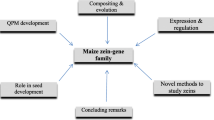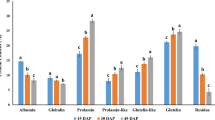Abstract
Corn protein is largely made up of a group of nutritionally limited storage proteins known as zein. The reduction of zein can be achieved by a transcriptional mutation, opaque2 (o2), or a transgene targeting zein through RNA interference (RNAi). Zein reduction results in an increase of more nutritionally balanced non-zein proteins, and therefore enhance the overall quality of corn protein. In this study, the composition of mature kernels and the transcriptional profile of developing kernels of these two types of zein reduced kernels were compared. Both zein reduced kernels contained higher levels of lysine and tryptophan and free amino acids were 10–20-folds more abundant than the wild-type counterpart. We also found that free lysine contributed partially to the increased lysine in o2 kernels while protein-bound lysine was mainly responsible for the increased lysine in transgenic zein reduction (TZR) kernels. Although they had relatively similar gene expression patterns in developing endosperm, o2 kernels had greater transcriptional changes than TZR kernels in general. A number of transcripts that were specifically down-regulated in o2 were identified. Many promoter sequences of these transcripts contain putative O2 binding motifs, suggesting that their expression is directly regulated by O2.








Similar content being viewed by others
References
Adams WR, Huang S, Kriz AL, Luethy MH (2004) Matrix-assisted laser desorption ionization time-of-flight mass spectrometry analysis of zeins in mature maize kernels. J Agric Food Chem 52:1842–1849
Arruda P, Kemper EL, Papes F, Leite A (2000) Regulation of lysine catabolism in higher plants. Trends Plant Sci 5:324–330
Azevedo RA, Lancien M, Lea PJ (2006) The aspartic acid metabolic pathway, an exciting and essential pathway in plants. Amino Acids 30:143–162
Bass HW, Webster C, OB GR, Roberts JK, Boston RS (1992) A maize ribosome-inactivating protein is controlled by the transcriptional activator Opaque-2. Plant Cell 4:225–234
Brochetto-Braga MR, Leite A, Arruda P (1992) Partial purification and characterization of lysine-ketoglutarate reductase in normal and opaque-2 maize endosperms. Plant Physiol 98:1139–1147
Burgoon KG, Hansen JA, Knabe DA, Bockholt AJ (1992) Nutritional value of quality protein maize for starter and finisher swine. J Anim Sci 70:811–817
Chang CS (1988) Measuring density and porosity of grain kernels using a gas pycnometer. Cereal Chem 65:13–15
Coleman CE, Larkins BA (1999) The prolamins of maize. In: Shewry PR, Casey R (eds) Seed proteins. Kluwer, Dordrecht, pp 109–139
Damerval C, de Vienne D (1993) Quantification of dominance for proteins pleiotropically affected by opaque-2 in maize. Heredity 73:38–51
Damerval C, Le Guilloux M (1998) Characterization of novel proteins affected by the o2 mutation and expressed during maize endosperm development. Mol Gen Genet 257:354–361
Dyer DJ, Feng P (1997) NIR destined to be major analytical influence. Feedstuffs 69:16–25
FAO (1992) Maize in human nutrition. In: Food and nutrition. Food and Agriculture Organization of the United Nations (FAO), Rome, Italy
Fire A, Xu S, Montgomery MK, Kostas SA, Driver SE, Mello CC (1998) Potent and specific genetic interference by double-stranded RNA in Caenorhabditis elegans. Nature 391:806–811
Gaziola SA, Alessi ES, Guimaraes PE, Damerval C, Azevedo RA (1999) Quality protein maize: a biochemical study of enzymes involved in lysine metabolism. J Agric Food Chem 47:1268–1275
Gibbon BC, Larkins BA (2005) Molecular genetic approaches to developing quality protein maize. Trends Genet 21:227–233
Gupta D, Kovac I (1975) Cold tolerance of parents, single, 3-way and double crosses of opaque-2 maize inbreds and their normal analogues. Euphytica 24:245–250
Habben JE, Kirleis AW, Larkins BA (1993) The origin of lysine-containing proteins in opaque-2 maize endosperm. Plant Mol Biol 23:825–838
Habben JE, Moro GL, Hunter BG, Hamaker BR, Larkins BA (1995) Elongation factor 1 alpha concentration is highly correlated with the lysine content of maize endosperm. Proc Natl Acad Sci USA 92:8640–8644
Harper AE, Benevenga NJ, Wohlhueter RM (1970) Effects of ingestion of disproportionate amounts of amino acids. Physiol Rev 50:428–558
Hartings H, Maddaloni M, Lazzaroni N, Di Fonzo N, Motto M, Salamini F, Thompson R (1989) The O2 gene which regulates zein deposition in maize endosperm encodes a protein with structural homologies to transcriptional activators. EMBO J 8:2795–2801
Huang S, Adams WR, Zhou Q, Malloy KP, Voyles DA, Anthony J, Kriz AL, Luethy MH (2004) Improving nutritional quality of maize proteins by expressing sense and antisense zein genes. J Agric Food Chem 52:1958–1964
Huang S, Kruger DE, Frizzi A, D’Ordine RL, Florida CA, Adams WR, Brown WE, Luethy MH (2005) High-lysine corn produced by the combination of enhanced lysine biosynthesis and reduced zein accumulation. Plant Biotechnol J 3:555–569
Huang S, Frizzi A, Florida CA, Kruger DE, Luethy MH (2006) High lysine and high tryptophan transgenic maize resulting from the reduction of both 19- and 22-kD alpha-zeins. Plant Mol Biol 61:525–535
Hunter BG, Beatty MK, Singletary GW, Hamaker BR, Dilkes BP, Larkins BA, Jung R (2002) Maize opaque endosperm mutations create extensive changes in patterns of gene expression. Plant Cell 14:2591–2612
Jia H, Nettleton D, Peterson JM, Vazquez-Carrillo G, Jannink J-L, Scott MP (2007) Comparison of transcript profiles in wild-type and o2 maize endosperm in different genetic backgrounds. Crop Sci 47:45–59
Johnson LA, Hardy CL, Baumel CP, Yu TH, Sell JL (2001) Identifying valuable corn quality traits for livestock feed. Cereal Foods World 46:472–481
Kemper EL, Neto GC, Papes F, Moraes KC, Leite A, Arruda P (1999) The role of opaque2 in the control of lysine-degrading activities in developing maize endosperm. Plant Cell 11:1981–1994
Kodrzycki R, Boston RS, Larkins BA (1989) The opaque-2 mutation of maize differentially reduces zein gene transcription. Plant Cell 1:105–114
Krivanek AF, De Groote H, Gunaratna NS, Diallo AO, Friesen D (2007) Breeding and disseminating quality protein maize (QPM) for Africa. African J Biotechnol 6:312–324
Lam H, Sun SSM, Shao G (2008) Abiotic stress tolerance conferred by J-domain containing proteins. US Patent Application 20080109920A1
Lohaus G, Buker M, Hussmann M, Soave C, Heldt HW (1998) Transport of amino acids with special emphasis on the synthesis and transport of asparagine in the Illinois low protein and Illinois high protein strains of maize. Planta 205:181–188
Lohmer S, Maddaloni M, Motto M, Di Fonzo N, Hartings H, Salamini F, Thompson RD (1991) The maize regulatory locus Opaque-2 encodes a DNA-binding protein which activates the transcription of the b-32 gene. EMBO J 10:617–624
Mertz ET, Bates LS, Nelson OE (1964) Mutant gene that changes protein composition and increases lysine content of maize endosperm. Science 145:279–280
Misra PS, Mertz ET, Glover DV (1975) Studies on corn proteins. VIII. Free amino acid content of opaque-2 and double mutants. Cereal Chem 52:844–848
Motto M, Maddaloni M, Ponziani G, Brembilla M, Marotta R, Di Fonzo N, Soave C, Thompson RD, Salamini F (1988) Molecular cloning of the o2–m5 allele of Zea mays using transposon marking. Mol Gen Genet 212:488–494
Murphy JJ, Dalby A (1971) Changes in the protein fractions of developing normal and opaque-2 maize endosperm. Cereal Chem 48:336–349
Nelson OE, Mertz ET, Bates LS (1965) Second mutant gene affecting the amino acid pattern of maize endosperm proteins. Science 150:1469–1470
Prasanna BM, Vasal SK, Kassahun B, Singh NN (2001) Quality protein maize. Curr Sci 81:1308–1319
Puckett JL, Kriz AL (1991) Globulin gene expression in opaque-2 and floury-2 mutant maize embryos. Maydica 36:161–167
Robutti JL, Hoseney RC, Wasson CE (1974) Modified opaque-2 corn endosperms. II. Structure viewed with a scanning electron microscope. Cereal Chem 51:173–180
Schmidt RJ, Burr FA, Burr B (1987) Transposon tagging and molecular analysis of the maize regulatory locus opaque-2. Science 238:960–963
Schmidt RJ, Burr FA, Aukerman MJ, Burr B (1990) Maize regulatory gene opaque-2 encodes a protein with a “leucine-zipper” motif that binds to zein DNA. Proc Natl Acad Sci USA 87:46–50
Segal G, Song R, Messing J (2003) A new opaque variant of maize by a single dominant RNA-interference-inducing transgene. Genetics 165:387–397
Shewry PR (2007) Improving the protein content and composition of cereal grain. J Cereal Sci 46:239–250
Soave C, Tardani L, Di Fonzo N, Salamini F (1981) Zein level in maize endosperm depends on a protein under control of the opaque-2 and opaque-6 loci. Cell 27:403–410
Stepansky A, Less H, Angelovici R, Aharon R, Zhu X, Galili G (2006) Lysine catabolism, an effective versatile regulator of lysine level in plants. Amino Acids 30:121–125
Sullivan JS, Knabe DA, Bockholt AJ, Gregg EJ (1989) Nutritional value of quality protein maize and food corn for starter and growth pigs. J Anim Sci 67:1285–1292
Sun Y, Carneiro N, Clore AM, Moro GL, Habben JE, Larkins BA (1997) Characterization of maize elongation factor 1A and its relationship to protein quality in the endosperm. Plant Physiol 115:1101–1107
Thompson GA, Larkins BA (1994) Characterization of zein genes and their regulation in maize endosperm. In: Freeling M, Walbot V (eds) The maize handbook. Springer, New York, pp 639–647
Tiwari PN, Gambhir PN, Rajan TS (1974) Rapid and nondestructive determination of seed oil by pulsed nuclear magnetic resonance technique. JAOCS 51:104–109
Wang X, Larkins BA (2001) Genetic analysis of amino acid accumulation in opaque-2 maize endosperm. Plant Physiol 125:1766–1777
Wang X, Stumpf DK, Larkins BA (2001) Aspartate kinase 2. A candidate gene of a quantitative trait locus influencing free amino acid content in maize endosperm. Plant Physiol 125:1778–1787
Yamaguchi-Shinozaki K, Shinozaki K (1993) The plant hormone abscisic acid mediates the drought-induced expression but not the seed-specific expression of rd22, a gene responsive to dehydration stress in Arabidopsis thaliana. Mol Gen Genet 238:17–25
Yunes JA, Cord Neto G, da Silva MJ, Leite A, Ottoboni LM, Arruda P (1994) The transcriptional activator Opaque2 recognizes two different target sequences in the 22-kD-like alpha-prolamin genes. Plant Cell 6:237–249
Acknowledgments
We are grateful to the Monsanto trait development group at Mystic for the greenhouse care, and Charles Hagen for editing the manuscript.
Author information
Authors and Affiliations
Corresponding author
Electronic supplementary material
Below is the link to the electronic supplementary material.
Rights and permissions
About this article
Cite this article
Frizzi, A., Caldo, R.A., Morrell, J.A. et al. Compositional and transcriptional analyses of reduced zein kernels derived from the opaque2 mutation and RNAi suppression. Plant Mol Biol 73, 569–585 (2010). https://doi.org/10.1007/s11103-010-9644-1
Received:
Accepted:
Published:
Issue Date:
DOI: https://doi.org/10.1007/s11103-010-9644-1




